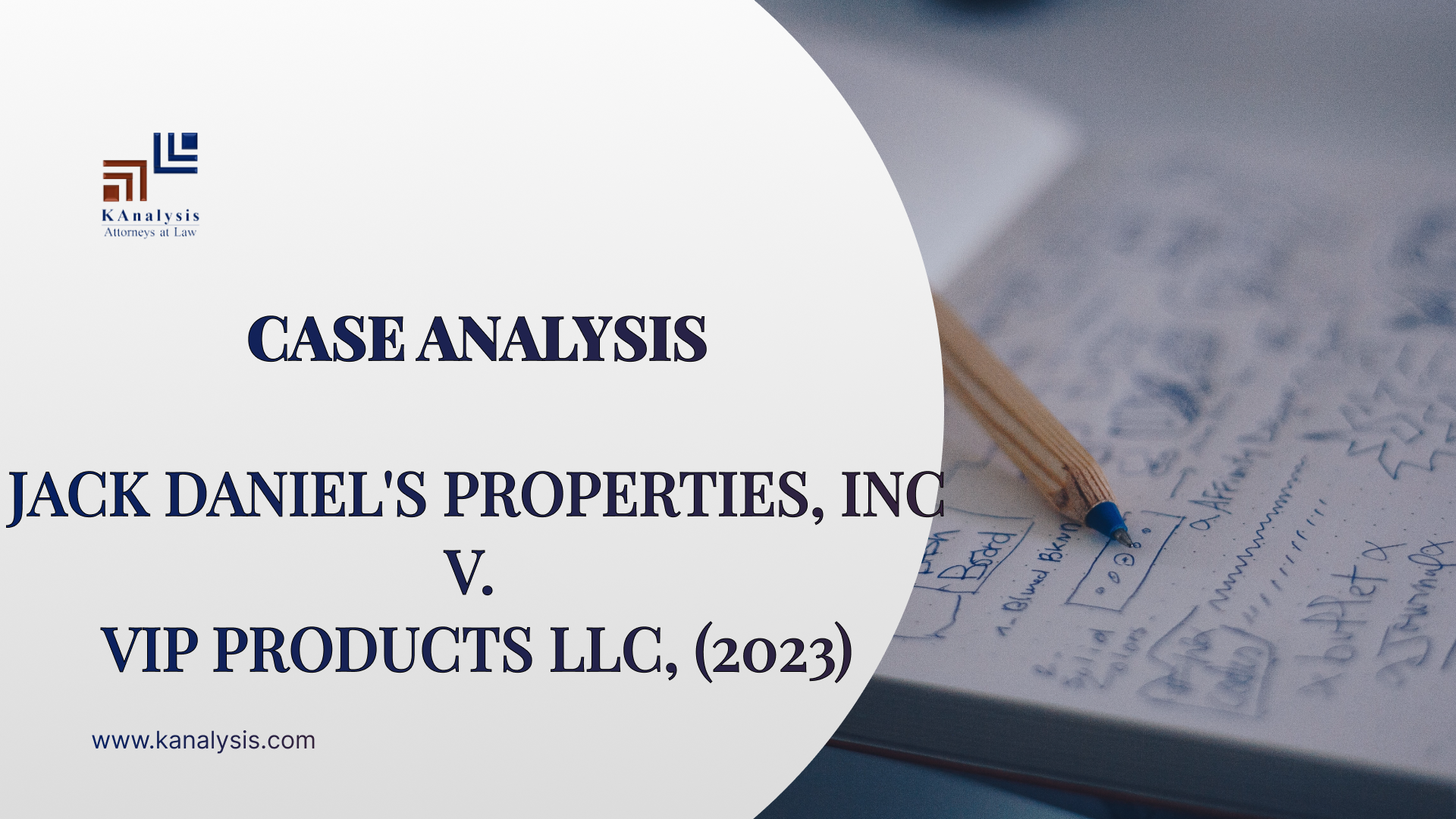The case of Jack Daniel’s Properties, Inc. v. VIP Products LLC involves a dispute between Jack Daniel’s, a well-known distillery, and VIP Products, a company that manufactures and sells pet toys. The specific issue at hand was whether VIP Products’ dog toy, called the “Bad Spaniels Silly Squeaker,” infringed on Jack Daniel’s trademark rights. VIP made a chewable dog toy that looked like a Jack Daniel’s whiskey bottle; the words were changed into dog puns as a parody from “Jack Daniel’s” to “Bad Spaniels.” Similarly, adding to the parody “Old No. 7 Brand Tennessee Sour Mash Whiskey” was turned into “The Old No. 2 On Your Tennessee Carpet.” Jack Daniel’s approached the court to restrict VIP products from selling the toy.
Jack Daniel’s argued that VIP Products’ dog toy infringed on its trademark rights and diluted the distinctive trade dress of its famous Jack Daniel’s whiskey bottle as the dog toy resembled the whiskey bottle with slight modifications. Jack Daniel’s claimed that this unauthorized use created a likelihood of confusion among consumers and diluted the distinctiveness of its brand.
The court analyzed several factors to determine trademark infringement, including the strength and distinctiveness of Jack Daniel’s trademarks, the similarity between the marks, the degree of consumer care, the relatedness of the goods, and evidence of actual confusion. The court ultimately ruled in favor of Jack Daniel’s, stating that VIP Products’ use of the dog toy constituted trademark infringement and dilution, and ordered VIP products to cease the production and sale of the infringing dog toy.
ISSUES
- Whether humorous use of another’s trademark as one’s own on a commercial product is subject to the Lanham Act’s traditional likelihood-of-confusion analysis, or instead receives heightened First Amendment protection from trademark-infringement claims.
- Whether humorous use of another’s mark as one’s own on a commercial product is “non-commercial” under 15 U.S.C.[1] § 1125(c)(3)(C), thus barring as a matter of law a claim of dilution by tarnishment under the Trademark Dilution Act.[2]
PLAINTIFF PRAYED
Jack Daniel’s filed suit against VIP Products alleging trademark infringement under the federal Lanham Act’s likelihood-of-confusion framework and trademark dilution by tarnishment, damaging Jack Daniel’s mark by negatively associating it with dog poop.
IMPORTANT CONCEPTS INVOLVED
- ROGERS TEST: Thistest requires the defendant to make a threshold legal showing that its allegedly infringing use is part of an expressive work protected by the First Amendment (freedom of expression). If successful, then the plaintiff claiming has to satisfy the likelihood-of-confusion test & that it has a valid protectable trademark, and/or the mark is either not artistically relevant to the underlying work or explicitly misleading as to the source or content of the work.[3]
- TRADEMARK DILUTION: “Dilution by blurring” refers to any use that diminishes the distinctiveness of the original mark. To determine the dilution, the court considers factors such as the similarity of the infringing mark to the famous mark, the inherent distinctiveness of the famous mark, the exclusivity of its use, its level of recognition, intended association, and actual association between the two marks. “Dilution by tarnishment” refers to harm caused to the reputation of the famous mark by the alleged infringement. However, certain uses of a famous mark, such as fair use, news coverage, commentary, and non-commercial use, are not considered dilution by blurring or tarnishment.
CASE TIMELINE
- The US District Court of Arizona found that VIP had used trademarked elements without proper authorization and determined that VIP’s use was not protected by the First Amendment while concluding that VIP’s use did not fall under the exceptions or defenses, such as fair use, and issued an injunction against VIP prohibiting them from selling the toy that incorporated the trademarked elements.
- On appeal, the Ninth Circuit applied the Rogers test,[4] a legal standard used to evaluate whether the use of a trademark in an expressive work infringes on the trademark owner’s rights, balancing the First Amendment rights of the user against the likelihood of consumer confusion. It disagreed with the finding of dilution by tarnishment, which refers to the negative association or harm caused to a trademark’s reputation or distinctiveness, and, invoked an exception provided in the Trademark Dilution Revision Act,[5] which states that the “non-commercial use of a mark” is not subject to dilution claims.
- Jack Daniel’s, filed for a writ of certiorari in the Supreme Court, seeking a review of the case and contending that VIP’s use of the trademark constituted a violation of trademark law as VIP was trading upon their goodwill and was using the mark as its own trademark. The Court granted certiorari and after considering the arguments and evidence, issued its unanimous ruling which rejected the contentions surrounding the application of the Rogers test and found in favor of Jack Daniel’s, determining that VIP’s use of the parody of Jack Daniel’s trademark as its own trademark constituted a violation of trademark law.
SUPREME COURT JUDGMENT AT GLANCE
1. When an alleged infringer uses a trademark as a designation of source for the infringer’s own goods, the Rogers test does not apply.
(a) The Second Circuit created the Rogers test for titles of “artistic works” based on its view that such titles have an “expressive element” implicating “First Amendment values” and carry only a “slight risk” of confusing consumers about the “source or content” of the underlying work.
(b) Over the decades, lower courts[6] adopting Rogers have confined it to similar cases, in which a trademark is used not to designate a work’s source, but solely to perform some other expressive function. Thus, whatever Rogers’ merit, it has not insulated from ordinary trademark scrutiny the use of trademarks as trademarks.
(c) Consumer confusion about the source is most likely to arise when someone uses another’s trademark as a trademark. In such cases, Rogers has no proper application. Nor does that result in change because the use of a mark has other expressive content. Under the Ninth Circuit’s approach, Bad Spaniels was automatically entitled to Rogers’ protection because it “communicated a humorous message” and it was mistaken to believe that the First Amendment demanded such a result. When a mark is used as a source identifier, the First Amendment does not demand a threshold inquiry.
(b) In this case, VIP conceded that it used the Bad Spaniels trademark and trade dress as source identifiers and VIP has said and done more in the same direction with respect to Bad Spaniels and other similar products. The only question remaining is whether the Bad Spaniels trademarks are likely to cause confusion. Although VIP’s effort to parody Jack Daniel’s does not justify the use of the Rogers test, it may make a difference in the standard trademark analysis.
2. The Lanham Act’s exclusion[7] from dilution liability for “any non-commercial use of a mark,” does not shield parody, criticism, or commentary when an alleged diluter uses a mark as a designation of source for its own goods. The Ninth Circuit’s holding to the contrary puts the non-commercial exclusion in conflict with the statute’s fair-use exclusion. The latter exclusion specifically covers uses “parodying, criticizing, or commenting upon” a famous mark owner,[8] but does not apply when the use is “as a designation of source for the person’s own goods or services”.[9] Given that carve-out, parody is exempt from liability only if not used to designate source.
STAND OF INDIAN COURTS
| Sno. | Case Title | Forum | Relevant Portion(s) |
| 1. | Wiley Eastern Ltd. and Ors. v. Indian Institute of Management, (1996) 61 DLT 281 View Judgment | Delhi High Court | The Court linked fair dealing under Section 52 with the freedom of speech and expression under Article 19(1)(a) of the Constitution of India and held that its inclusion in the Copyright Act is necessary so that research, private study, criticism, review, or reporting of current events could be done freely. |
| 2. | TATA Sons Ltd. v. Greenpeace International & Anr. 178 (2011) DLT 705 View Judgment | Delhi High Court | Tata Sons Limited v Greenpeace International sets a precedent in favour of parody creator instead of IPR proprietor. This not only strengthens the fundamental right to free speech and expression but also clears the ambiguity over what is to be considered a parody and what is to be considered an outright infringement of intellectual property rights. Few pointers that have to be kept in mind to determine the same are: i) The work of parody must prima facie remind the original work. ii) It must be an entirely exclusive work of its own capable of distinguishing itself from the original work. iii) if it creates confusion in the minds of the viewer/consumer of parody as to what is original work and what is parody then it is an outright infringement of the IPR of the proprietor. iv) The Parody must be presented in such a clever and witty form that it does not in the minds of the consumer connects itself to the original work. |
[1] Title 15 of the United States Code.
[2] The Federal Trademark Dilution Act of 1995 (Pub. L. 104–98).
[3] Gordon, 909 F.3d at 264.
[4] See Rogers v. Grimaldi, 875 F. 2d 994. When “expressive works” are involved, VIP contended, that test requires dismissal of an infringement claim at the outset unless the complainant can show either (1) that the challenged use of a mark “has no artistic relevance to the underlying work” or (2) that it “explicitly misleads as to the source or the content of the work.”
[5] The Federal Trademark Dilution Act of 1995 (Pub. L. 104–98).
[6] See, e.g., Mattel, Inc. v. MCA Records, Inc., 296 F. 3d 894, 901 (use of the Barbie name in band’s song “Barbie Girl” was “not [as] a source identifier”).
[7] See. §1125(c)(3)(C) of The Lanham Act (also known as the Trademark Act) of 1946, a federal statute governing service mark, trademarks, and unfair competition.
[8] See §1125(c)(3)(A)(ii),
[9] See §1125(c)(3)(A).



